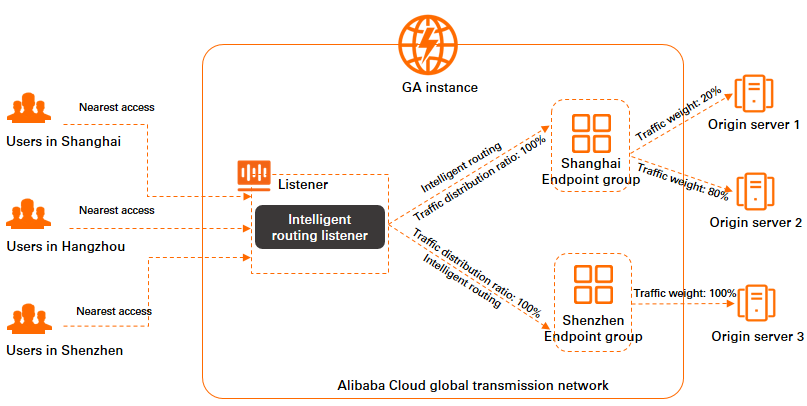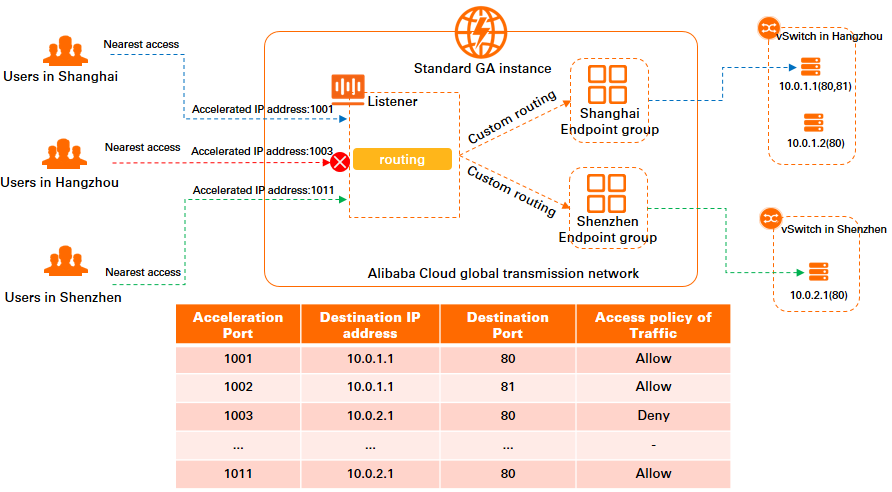After you create a standard Global Accelerator (GA) instance, you must configure listeners for the GA instance. A listener listens for connection requests and distributes the requests to endpoints based on the routing type of the listener that is associated with the endpoint group.
Listener protocols
You can create up to 10 listeners for each GA instance. The following listener protocols are supported: TCP, UDP, HTTP, and HTTPS. The following table describes the features and usage scenarios of the listener protocols.
Protocol | Description | Scenario |
TCP |
|
|
UDP |
| Applicable to scenarios in which real-time transmission outweighs reliability, such as video conferencing and real-time quote services. |
HTTP |
|
|
HTTPS |
|
|
Routing listeners
GA provides intelligent routing listeners and custom routing listeners. You can select a routing type based on your business requirements.
Custom routing listeners are in invitational preview. To use custom routing listeners, submit an application to your account manager. After your application is approved, you can use custom routing listeners.
Intelligent routing listeners
Intelligent routing is the default routing type of original listeners. After you configure an intelligent routing listener for a GA instance, the GA instance selects a nearby and healthy endpoint group based on network latency and forwards client requests to the optimal endpoint in the endpoint group. The network latency varies based on geographical locations and network hops.
This method is ideal for applications that require fine-grained control of global traffic. You can specify the traffic weights of endpoint groups and endpoints based on your business requirements. Examples: blue-green deployment, A/B testing, multi-region deployment, service discontinuation or update in specific regions, and cross-region disaster recovery. For information about usage scenarios and examples, see Distribute traffic across endpoint groups in different scenarios and Examples on how to configure the traffic distribution feature for multiple endpoint groups.
Intelligent routing listeners support TCP, UDP, HTTP, and HTTPS.

Custom routing listeners
After you configure a custom routing listener for a GA instance, the instance generates a port mapping table based on the listener port range, port ranges of the associated endpoint groups, and IP addresses of endpoints (vSwitches). The custom routing listener forwards client requests to specific IP addresses and ports in the vSwitches based on the port mapping table.
Custom routing listeners are ideal for scenarios in which you want to forward traffic from clients to specified backend servers. Examples: multiplayer online games, video conferencing, and virtual classrooms. For information about how custom routing listeners work and how to use custom routing listeners, see How custom routing listeners work.
Custom routing listeners support only TCP and UDP. You can specify protocols when you configure endpoint groups. You can specify TCP, UDP, or both for the destination port range of each endpoint group.

The routing listeners of a GA instance must be of the same routing type. You cannot change the routing type of a listener after you complete the configuration. For information about the differences between the two types of routing listeners, see the "Comparison between intelligent routing listeners and custom routing listeners" section of the How custom routing listeners work topic.
Listener ports
Listener ports are used to receive requests and forward the requests to endpoints. Different types of routing listeners are subject to different limits.
Intelligent routing listener ports
Intelligent routing listeners consist of basic listeners and advanced listeners. You can specify multiple ports for each intelligent routing listener.
If you create intelligent routing listeners that use the same protocol for a GA instance, you must configure different ports for the listeners.
Basic listeners
The following table describes the quotas for the number of ports that are supported by different protocols. For TCP and UDP listeners, you can increase the gaplus_quota_port_per_listener quota. For more information, see Manage GA quotas.
Listener protocol
Listener port range
Listener port quota
TCP
1-65499
30.
Separate multiple listener ports with commas (,). Example: 80,90,8080.
You can use a hyphen (-) to specify a port range. For example, you can enter 80-83 to specify ports 80, 81, 82, and 83.
UDP
1-65499
30.
Separate multiple listener ports with commas (,). Example: 80,90,8080.
You can use a hyphen (-) to specify a port range. For example, you can enter 80-83 to specify ports 80, 81, 82, and 83.
HTTP
1-65499
1.
HTTPS
1-65499
1.
Advanced listeners
You can specify more than 300 consecutive listener ports for a TCP listener or a UDP listener. An advanced listener is a listener that contains more than 300 consecutive listener ports. The following limits apply to advanced listeners:
You can directly create advanced listeners for GA instances that were created after January 8, 2022. If your GA instance was created before January 8, 2022 and you want to use advanced listeners, contact your account manager to upgrade your GA instance.
You must specify more than 300 ports for an advanced listener. The number of ports that you specify must not exceed 65,499.
You can create only one advanced listener for a GA instance.
You can specify only consecutive ports. For example, you can set the port range to 1-350. You cannot set the port range to 1,3-350.
If the acceleration region of a GA instance is a point of presence (POP) of Alibaba Cloud, you cannot create an advanced listener for the GA instance.
NoteTo check whether an available acceleration region of a standard GA instance is a POP of Alibaba Cloud, call the ListAvailableBusiRegions operation.
For example, you can create the following listeners for a GA instance: a TCP listener whose listener ports are from 1 to 400, a TCP listener whose listener port is 443, a UDP listener whose listener ports are from 200 to 210, and a UDP listener port whose listener ports are from 230 to 240. The TCP listener whose listener ports are from 1 to 400 is an advanced listener.
Custom routing listener ports
The following limits apply to custom routing listener ports:
You can specify ports that range from 1 to 65499 for a custom routing listener. Ports 25, 250, 4789, and 4790 are reserved by the system. When a port mapping table is generated, the system-reserved ports are ignored. You cannot configure port 6081 for pay-as-you-go Global Accelerator instances.
The listener port range you specify determines the number of ports in the endpoint group that is associated with the listener and the number of IP addresses of all vSwitches in the endpoint. The following requirement must be met:
Number of listening ports (minus the number of system-reserved ports) ≥ Number of all ports in the endpoint group × Number of IP addresses of all vSwitches in the endpoint. We recommend that you specify a large port range for the listener.For example, if you set the destination port range of endpoint groups to 81-85 and all vSwitches that are used as endpoints provide 16 IP addresses, the listener port range must contain at least 80 ports. You can set the port range of the listener to 101-180. If you set the port range of the listener to 101-179, the listener cannot be created.
After you configure listener ports, you cannot remove ports that exist in the port mapping table when you modify the port range.
For example, the original listening port range is 100-10000, and a mapping is established between port 199 and the destination port 80 of the endpoint in the port mapping table. You can expand the listening port range to 20-10000. You cannot narrow the listening port range to 200-10000.
The listening ports of different listeners under the same GA instance cannot overlap.